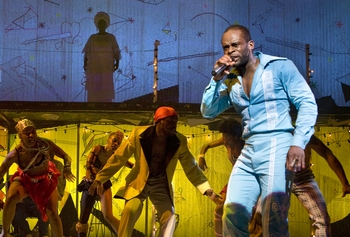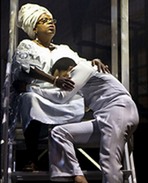SITE GUIDE
SEARCH
REVIEWS
REVIEW ARCHIVES
ADVERTISING AT CURTAINUP
FEATURES
NEWS
Etcetera and
Short Term Listings
LISTINGS
Broadway
Off-Broadway
NYC Restaurants
BOOKS and CDs
OTHER PLACES
Berkshires
London
California
New Jersey
DC
Connecticut
Philadelphia
Elsewhere
QUOTES
TKTS
PLAYWRIGHTS' ALBUMS
LETTERS TO EDITOR
FILM
LINKS
MISCELLANEOUS
Free Updates
Masthead
A CurtainUp Review
Fela!
Fela! A Return Engagement
Understandably stripped of the environmental décor that was previously affixed to the walls of the Eugene O’Neill Theater during its initial run, nothing else has been stripped away from a show that is primarily driven by the officiating presence and dynamic performance of Sahr Ngaujah, as Fela, (played at some performances by Adesola Osakalumi) as it is by the spectacularly undulating bodies of the colorfully garbed male and female dancers, as directed and choreographed by the inimitable Bill T. Jones. In primary character roles, Melanie Marshall is terrific as Fela’s mother Funmilayo, as is Paulette Ivory as his first wife Sandra. My quibbles (see my original review below) remain the same as they were originally. Be advised that there is no need for hearing aids. Only be prepared to stand, shout and shake on command unless you choose to be the one left sitting. The capacity audience at the performance I attended appeared mainly overjoyed to be participants. Fela could still use a little trimming running close to 2 hours and 45 minutes. Current Production Notes Book by Jim Lewis & Bill T. Jones Music by and Lyrics by Fela Anikulap-Kuti Directed and Choreographed by Bill. T. Jones Cast: Sahr Ngaujah, Adesola Osakalumi (Fela Anikulapo-Kuti), Melanie Marshall (Funmilayo), Paulette Ivory (Sandra), Ismael Kouyate (Ismael), Gelan Lambert (J.K. Braimah, Tap Dancer, Egungun), Rasaan-Elijah “Talu” Green (Djembe-“Mustafa”) Al Hirschfeld Theatre 302 West 45h Street at 8th Avenue. (212) 239 – 6200 Tickets: $47 - $132. Performances: Monday, Tuesday at 7pm; Wednesday at 2pm and 7:30pm; Thursday at 7pm; Friday at 8pm; Saturday at 2pm & 8pm. DARK SUNDAY. From 07/09/12 Opened 07/12/12 Ends 08/04/12 Review by Simon Saltzman based on performance 07/10/12 Original review with song list below |
The original review byy Simon Saltzman

Sahr Ngaujah and members of the cast (Photo: Monique Carboni)
|
|
This country treats life like it is garbage..—Fela
|

Lillias White and Kevin Mambo
(Photo: Monique Carboni) |
There have been changes, like shortening the musical numbers since I first saw the show, but none that strike me as altering the show's basic structure as part concert, part dance and part narrative. The show was originally clocked at 2 hours 40 minutes. It now runs 2 hours 30 minutes. These parts collectively reflect a time of political and social unrest and rebellion in Nigeria. For those of us who saw and recall the amazing Sahr Ngaujah in the title role off-Broadway, it was a gift in a way to see his alternate on Broadway Kevin Mambo, who appeared most recently in the off-Broadway hit Ruined.
Though set during Fela's final concert at the Shrine in Lagos, Nigeria during the summer of 1978, six months after the death of Funmilayo, Fela's 78-year-old mother, a world-recognized feminist leader (now sung with emotional intensity by Lillias White), the musical still plays a bit confusingly with time. It remains, however, a testament to the visceral energy of all the performers as they appear to revel in the imaginative Nigerian-based dances created by the Tony award-winning Jones (Spring Awakening) who is also credited with more than 100 works for his dance company.
Filled as it is with the music of Fela Anikulapo-Kuti and saturated with Jones's original and resourceful dance vocabulary, the stage still isn't big enough to contain the dancers who often flood the aisles of the O'Neill Theater much as they did at 37 Arts Theater. At times frenetic and furious, at other times earthy and ethereal, all the dancing vibrates with life and the kind of daring that isn't seen very often on Broadway.
Although Jones's gift as a dance modernist is visible, it is his instinctual grasp of Fela's unique music — a fusion of African rhythms, jazz, and funky harmonies —that makes the dances so exciting. I still find the nightmarish ballet, in which Fela dreams of going to the land of dead spirits to be comforted by his dead mother, a bit too grotesque and pretentious.
Fela's ground-breaking songs are known for being provocative and appealing, but here they are used to great effect to engrave their brutal honesty of purpose directly into the gripping, often heartbreaking, story he relates and in which he actively participates.
At the Shrine (his space in Lagos, Nigeria), Fela, along with his assemblage of singers and dancers, have gathered for the funeral services of his mother. "We are going to party tonight," Fela shouts.For him, the funeral will be a celebration of Funmilayo's life. Her spirit returns at key moments to serve as inspiration and support to her son, whose political leanings have been hugely influenced by Sandra Isidore, now played with a liberated libido by Saycon Sengbloh), a beautiful woman he meets while in America. She is the one who introduces him to the writings of Malcolm X and Eldridge Cleaver and who ignites in him the spark of political and social rebellion.
Certainly just as personable, versatile and talented as is Ngaujah, Mambo also appears totally committed to portraying Fela, a man born into the indigenous Nigerian elite, a human rights activist who dedicated his life to opposing the tyrannical military rule of his country. His death in 1997 resulted from complications from AIDS.
Mambo (or is almost always center stage and looks trim and good in the glow of Robert Wierzel's dazzling lighting. He certainly rivets us with the story of his family: a father, a Christian schoolmaster, minister and master pianist; his mother; and his brother who became president of the Nigerian Medical Association in 1958. The family had hopes that Fela would also go into the medical profession. But he dropped out of his studies and enrolled at Trinity College's School of Music. Influenced by James Brown and Frank Sinatra and others, he returned to Nigeria, where he began to find his own authenticity by incorporating elements of traditional Yoruba and high life into his music.
There are a number of chilling and despairing moments within the narrative that include video and projections of the military government's brutality. His mother would die from injuries sustained after being thrown from a second story window by the police during a raid.
But the stage is ruled by Fela and an ensemble of stunningly beautiful dancers. Extravagantly and exotically costumed by designer Marina Draghini (who also designed the two-level setting that evokes the shrine), the dancers often come close enough to touch and bring into sharp relief the sexy, sensuous, and life-affirming pulse of Nigeria. Ismael Kaoyaté is back and terrific as an African chanter, but Gelan Lambert is new to the cast and kicks up plenty of dust with his ferocious tap-dancing. The earnest passion that drove this show a year ago has been feverishly re-activated as it balances Fela's socio-political calling with his career as a musician and composer and as the leader of Africa 70, a band that would become a huge success in West Africa and beyond.
My background knowledge of the music of Fela Anikulapo Kuti (although almost 70 albums of his work are now available) is limited. What a revelation it is. I always say my education is going to the theater. The show contains 28 songs; many, including the international hit “Zombie,” are trenchant enough to serve as the thematic threads. The book is a collaborative effort by Jim Lewis (who also contributed some lyrics) and Jones. If it isn't particularly strong on intimate or confrontational scenes, it accomplishes its task by following the extraordinary journey of a revolutionary man who ran for president and lost, was brutalized and arrested more than two hundred times, and ended up producing an incredible body of unique musical works.
The audience at the performance seemed eager to stay after the finale and party, as the cast is also not especially eager to leave the stage. At the performance I saw, Jones came down the aisle and to the lip of the stage during one number to encourage the dancers with waving hands. At the curtain calls, Jones came back again and kissed the hand of each performer as they left the stage. Wonderful moments. The renowned Antibalas and other members of the NYC Afrobeat community, under the direction of Aaron Johnson, again perform Kuti's rousing music live onstage.
Although this is a big expensive musical, it has no stars. So it will have to rely on the word-of-mouth generated by audiences that respond to the exuberant, pulsating dancing and to the Afro-Jazz music that isn't in the typical Broadway or even the pop-rock vein. It may be a hard sell but not impossible if the marketing is right. The savvy audience at the performance I attended gave it a thunderous standing ovation. But time will tell.
Editor's Note: The Off-Broadway production of Fela! was reviewed for Curtainup by Les Gutman and some of the changes pertaining to the songs are evident with the song list at the end of this and Les's review. To read his review go here
|
Fela! Book by Jim Lewis & Bill T. Jones Music and lyrics by Fela Anikulapo-Kuti Additional lyrics by Jim Lewis Additional music by Aaron Johnson & Jordan McLean Conceived by Bill T. Jones Jones, Jim Lewis & Stephen Hendel Directed and Choreographed by Bill T. Jones Cast: Sahr Ngaujah (Fela), Kevin Mambo (Fela alternate), Lillias White (Funmilayo), Saycon Sengbloh (Sandra), Ismael Kouyaté (African Chanter, Geraldo Pino, Orisa, Tortured Fela, Ensemble), Gelan Lambert (J.K. (tap dancer), Egundun). Scenic & Costume Designer: Marina Draghici Lighting Designer: Robert Wierzel Sound Designer: Robert Kaplowitz Projection Designer: Peter Nigrini Running Time: 2 hours 30 minutes including intermission Eugene O'Neill Theater, 230 West 49th Street (212) 239 – 6200 Tickets $27 - $122) Performances Tuesday at 7 PM, Wednesday – Friday at 8 PM, Saturday at 2 PM & 8 Pm, Sunday at 2 PM and 7 PM. From 10/19/09; opening 11/23/09. Closing 1/02/11 Review by Simon Saltzman based on matinee preview performance 11/21/09 |
|
Musical Numbers
| |
Act One
|
Act Two
*Lover and Pipeline, English lyrics by Jim Lewis **Rain music by Aaron Johnson and Jordan McLean, lyrics by Bill T. Jones and Jim Lewis
|

